Page 6 of 482
Illustrated table of contents0
Safety — Seats, seat belts and supplemental
restraint system1
Instruments and controls
Pre-driving checks and adjustments
Monitor, heater, air conditioner, audio, phone and
voice recognition systems
Starting and driving
In case of emergency
Appearance and care
Maintenance and do-it-yourself
Technical and consumer information
Index
2
3
4
5
6
7
8
9
10
Table of
Contents
Page 19 of 482

1-2Safety — Seats, seat belts and supplemental restraint system
SSS0133
WARNING
.Do not ride in a moving vehicle
when the seatback is reclined. This
can be dangerous. The shoulder belt
will not be against your body. In an
accident, you could be thrown into it
and receive neck or other serious
injuries. You could also slide under
the lap belt and receive serious
internal injuries.
. For the most effective protection
when the vehicle is in motion, the
seat should be upright. Always sit well back in the seat with both feet
on the floor and adjust the seat belt
properly. See “Precautions on seat
belt usage” (P.1-15) .
. After adjustment, gently rock in the
seat to make sure it is securely
locked.
. Do not leave children unattended
inside the vehicle. They could un-
knowingly activate switches or con-
trols. Unattended children could
become involved in serious acci-
dents. .
Do not adjust the driver’s seat while
driving so full attention may be
given to vehicle operation. The seat
may move suddenly and could
cause loss of control of the vehicle.
. The seatback should not be reclined
any more than needed for comfort.
Seat belts are most effective when
the passenger sits well back and
straight up in the seat. If the seat-
back is reclined, the risk of sliding
under the lap belt and being injured
is increased.
SEATS
Page 20 of 482
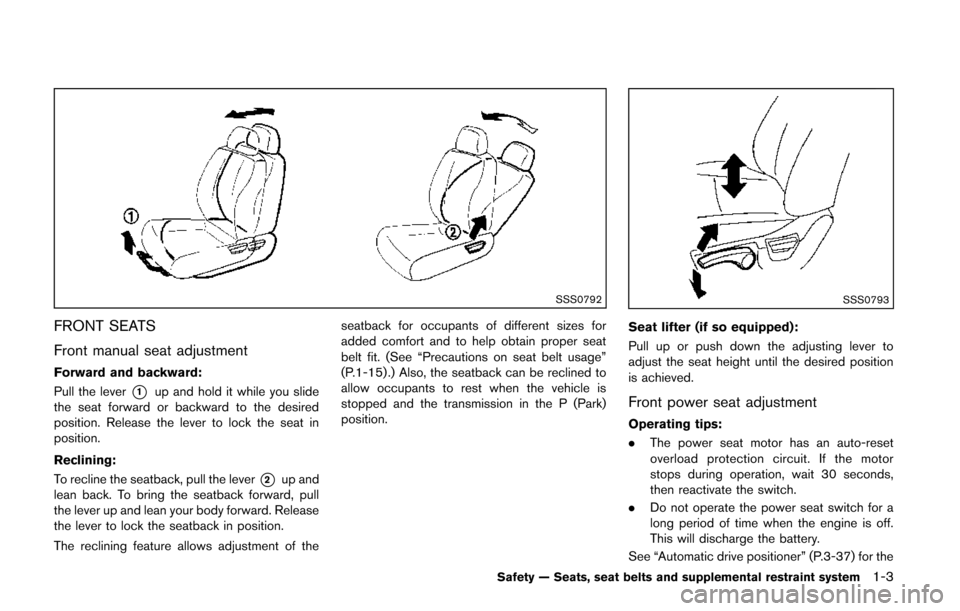
SSS0792
FRONT SEATS
Front manual seat adjustment
Forward and backward:
Pull the lever
*1up and hold it while you slide
the seat forward or backward to the desired
position. Release the lever to lock the seat in
position.
Reclining:
To recline the seatback, pull the lever
*2up and
lean back. To bring the seatback forward, pull
the lever up and lean your body forward. Release
the lever to lock the seatback in position.
The reclining feature allows adjustment of the seatback for occupants of different sizes for
added comfort and to help obtain proper seat
belt fit. (See “Precautions on seat belt usage”
(P.1-15) .) Also, the seatback can be reclined to
allow occupants to rest when the vehicle is
stopped and the transmission in the P (Park)
position.
SSS0793
Seat lifter (if so equipped):
Pull up or push down the adjusting lever to
adjust the seat height until the desired position
is achieved.
Front power seat adjustment
Operating tips:
.
The power seat motor has an auto-reset
overload protection circuit. If the motor
stops during operation, wait 30 seconds,
then reactivate the switch.
. Do not operate the power seat switch for a
long period of time when the engine is off.
This will discharge the battery.
See “Automatic drive positioner” (P.3-37) for the
Safety — Seats, seat belts and supplemental restraint system1-3
Page 21 of 482
1-4Safety — Seats, seat belts and supplemental restraint system
seat position memory function (if so equipped).
CAUTION
When adjusting the seat positions, be
sure not to contact any moving parts to
avoid possible injuries and/or da-
mages.
SSS1051
Forward and backward:
Moving the switch
*1forward or backward will
slide the seat forward or backward to the
desired position.
Reclining:
Move the recline switch
*2backward until the
desired angle is obtained. To bring the seatback
forward again, move the switch
*2forward.
The reclining feature allows adjustment of the
seatback for occupants of different sizes for
added comfort and to help obtain proper seat
belt fit. (See “Precautions on seat belt usage”
(P.1-15) .) Also, the seatback can be reclined to
allow occupants to rest when the vehicle is stopped and the transmission is in the P (Park)
position.
Page 23 of 482
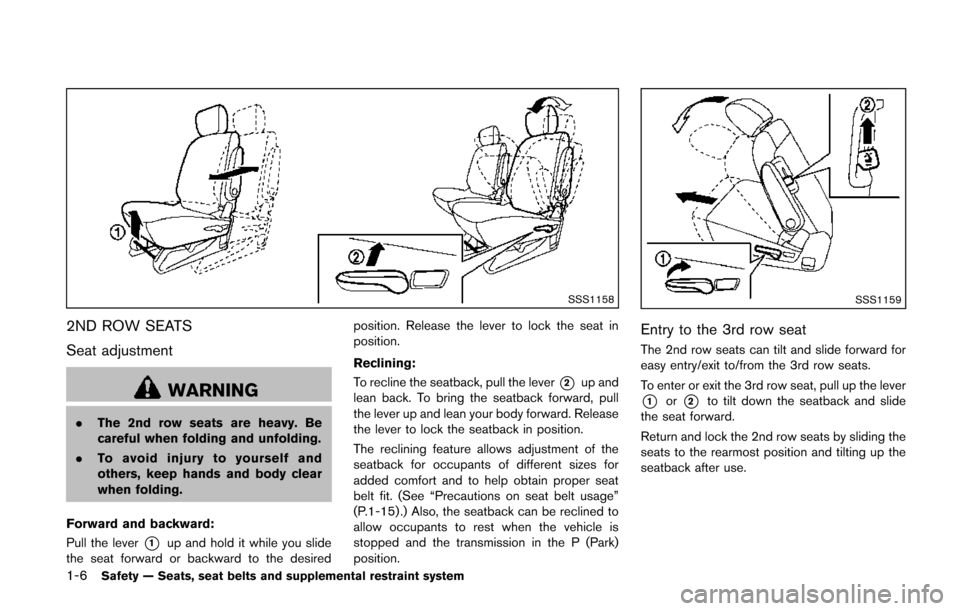
1-6Safety — Seats, seat belts and supplemental restraint system
SSS1158
2ND ROW SEATS
Seat adjustment
WARNING
.The 2nd row seats are heavy. Be
careful when folding and unfolding.
. To avoid injury to yourself and
others, keep hands and body clear
when folding.
Forward and backward:
Pull the lever
*1up and hold it while you slide
the seat forward or backward to the desired position. Release the lever to lock the seat in
position.
Reclining:
To recline the seatback, pull the lever
*2up and
lean back. To bring the seatback forward, pull
the lever up and lean your body forward. Release
the lever to lock the seatback in position.
The reclining feature allows adjustment of the
seatback for occupants of different sizes for
added comfort and to help obtain proper seat
belt fit. (See “Precautions on seat belt usage”
(P.1-15) .) Also, the seatback can be reclined to
allow occupants to rest when the vehicle is
stopped and the transmission in the P (Park)
position.
SSS1159
Entry to the 3rd row seat
The 2nd row seats can tilt and slide forward for
easy entry/exit to/from the 3rd row seats.
To enter or exit the 3rd row seat, pull up the lever
*1or*2to tilt down the seatback and slide
the seat forward.
Return and lock the 2nd row seats by sliding the
seats to the rearmost position and tilting up the
seatback after use.
Page 24 of 482
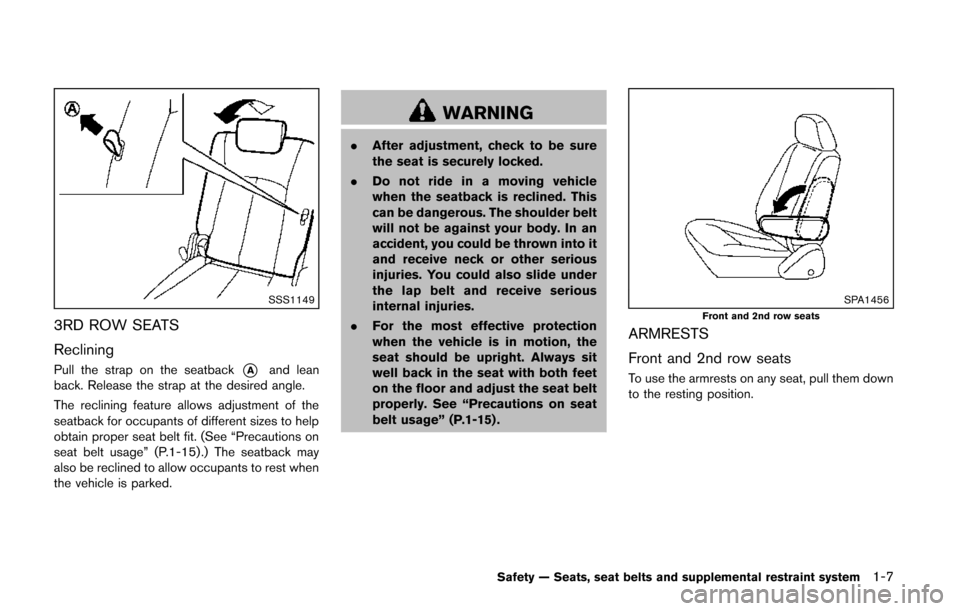
SSS1149
3RD ROW SEATS
Reclining
Pull the strap on the seatback*Aand lean
back. Release the strap at the desired angle.
The reclining feature allows adjustment of the
seatback for occupants of different sizes to help
obtain proper seat belt fit. (See “Precautions on
seat belt usage” (P.1-15) .) The seatback may
also be reclined to allow occupants to rest when
the vehicle is parked.
WARNING
. After adjustment, check to be sure
the seat is securely locked.
. Do not ride in a moving vehicle
when the seatback is reclined. This
can be dangerous. The shoulder belt
will not be against your body. In an
accident, you could be thrown into it
and receive neck or other serious
injuries. You could also slide under
the lap belt and receive serious
internal injuries.
. For the most effective protection
when the vehicle is in motion, the
seat should be upright. Always sit
well back in the seat with both feet
on the floor and adjust the seat belt
properly. See “Precautions on seat
belt usage” (P.1-15) .
SPA1456Front and 2nd row seats
ARMRESTS
Front and 2nd row seats
To use the armrests on any seat, pull them down
to the resting position.
Safety — Seats, seat belts and supplemental restraint system1-7
Page 27 of 482
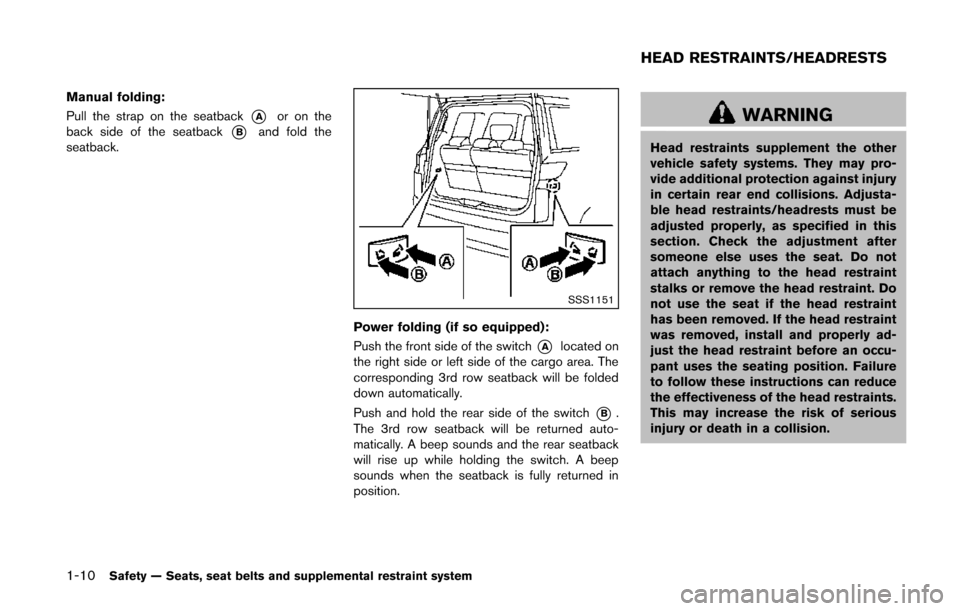
1-10Safety — Seats, seat belts and supplemental restraint system
Manual folding:
Pull the strap on the seatback
*Aor on the
back side of the seatback
*Band fold the
seatback.
SSS1151
Power folding (if so equipped):
Push the front side of the switch
*Alocated on
the right side or left side of the cargo area. The
corresponding 3rd row seatback will be folded
down automatically.
Push and hold the rear side of the switch
*B.
The 3rd row seatback will be returned auto-
matically. A beep sounds and the rear seatback
will rise up while holding the switch. A beep
sounds when the seatback is fully returned in
position.
WARNING
Head restraints supplement the other
vehicle safety systems. They may pro-
vide additional protection against injury
in certain rear end collisions. Adjusta-
ble head restraints/headrests must be
adjusted properly, as specified in this
section. Check the adjustment after
someone else uses the seat. Do not
attach anything to the head restraint
stalks or remove the head restraint. Do
not use the seat if the head restraint
has been removed. If the head restraint
was removed, install and properly ad-
just the head restraint before an occu-
pant uses the seating position. Failure
to follow these instructions can reduce
the effectiveness of the head restraints.
This may increase the risk of serious
injury or death in a collision.
HEAD RESTRAINTS/HEADRESTS
Page 28 of 482
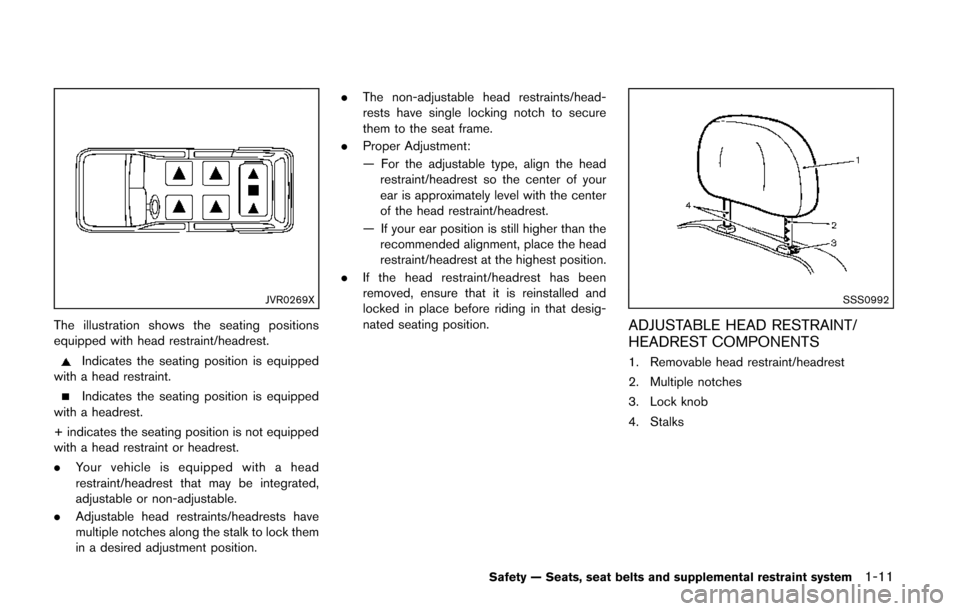
JVR0269X
The illustration shows the seating positions
equipped with head restraint/headrest.
Indicates the seating position is equipped
with a head restraint.
Indicates the seating position is equipped
with a headrest.
+ indicates the seating position is not equipped
with a head restraint or headrest.
. Your vehicle is equipped with a head
restraint/headrest that may be integrated,
adjustable or non-adjustable.
. Adjustable head restraints/headrests have
multiple notches along the stalk to lock them
in a desired adjustment position. .
The non-adjustable head restraints/head-
rests have single locking notch to secure
them to the seat frame.
. Proper Adjustment:
— For the adjustable type, align the head
restraint/headrest so the center of your
ear is approximately level with the center
of the head restraint/headrest.
— If your ear position is still higher than the recommended alignment, place the head
restraint/headrest at the highest position.
. If the head restraint/headrest has been
removed, ensure that it is reinstalled and
locked in place before riding in that desig-
nated seating position.
SSS0992
ADJUSTABLE HEAD RESTRAINT/
HEADREST COMPONENTS
1. Removable head restraint/headrest
2. Multiple notches
3. Lock knob
4. Stalks
Safety — Seats, seat belts and supplemental restraint system1-11